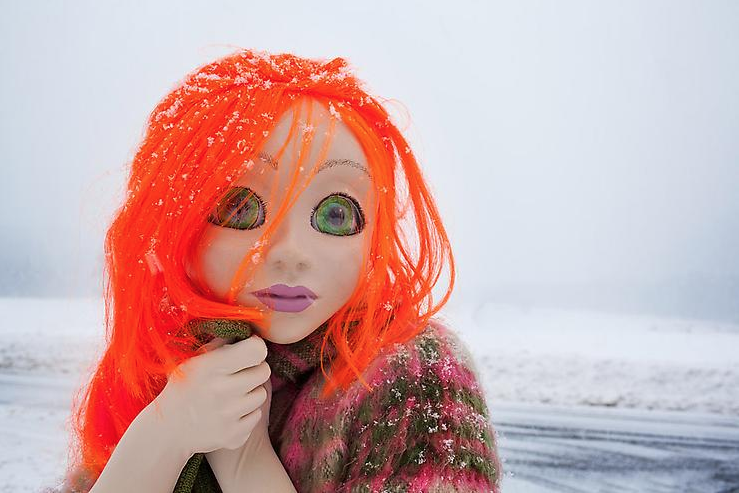
Laurie Simmons, Orange Hair/Snow/Close Up, 2014
After decades of photographing dolls, Laurie Simmons is now shooting real people—only with dollish eyes painted on their eyelids. “This interruption,” she acknowledges, “is so subtle people miss it at first.” The series follows work based on Simmons’ recent fascination with Kigurumi, performers in Japan who wear doll-like costumes. “Painting dollish features on human faces came next, after Simmons ‘got caught up’ in the hundreds of make-up tutorials available on YouTube,” writes The Telegraph’s Alice Vincent.
- Following the massacre at Charlie Hebdo headquarters in Paris, the Associated Press removed an image of Andres Serrano’s 1987 photo Piss Christ from its archives. In a commission by Creative Time Reports, Serrano chronicles that history while championing free expression today: “Artists map the culture and tell us where we stand. In doing so, artists are a free society’s greatest advocates and its best bulwarks. Their triumphs are civilization’s triumphs.”
- Master weavers in Afghanistan and Pakistan have long illustrated the world around them, featuring images of Kalashnikovs and F-16 fighters. Now new imagery is appearing on their hand-woven war rugs: unmanned aerial vehicles, aka drones.
- Interested in making visible “places and processes that would otherwise remain invisible,” James Bridle’s new film recreates through 3D modeling technology “unphotographable” facilities used in the UK’s detention and deportation program. His Seamless Transitions will be on view at the Photographers’ Gallery in London from February 6 through April 15.
- In his forthcoming directorial debut, French artist Pierre Bismuth sets out on search for a “mysterious hidden object”: a fake rock, dubbed Rocky II, that artist Ed Ruscha made and left somewhere in the Mojave Desert in 1979.
- “Sooner or later, all museum websites will be interconnected, so that any museum might take advantage of scholarship produced by any other,” writes Ken Johnson, who chronicles recent efforts by institutions to get art online and contextualized through rich content.
- Art historian David Joselit on the killing of Eric Garner, the art of William Pope.L, and visual evidence: “[H]ow can we account for the fact that the video of a police officer pressing his arm against Garner’s throat—a document that could not have been less ambiguous—did not ‘speak for itself’ before the members of a grand jury? If such a visual artifact can so blatantly fail in the task of representation before the law, both politically, as the proxy for an absent victim, and rhetorically, as evidence, doesn’t this present a challenge to how we define the politics of art?”
- Four partnerships between artists of color and institutions have won 2015 Joyce Awards. Designed to “engage, communicate and build communities,” these four collaborations will each get a cash prize of $50,000: installation artist Nari Ward and Power House Productions; visual artist Sanford Biggers and the Museum of Contemporary Art Detroit; composer/electronic musician Helado Negro and the St. Paul Chamber Orchestra’s Liquid Music Series; and actor/playwright
Sandra Delgado and Chicago’s Teatro Vista.
Follow Art News From Elsewhere on the Walker Art Center homepage or via @walkermag, the Walker’s editorial-focused Twitter feed.



